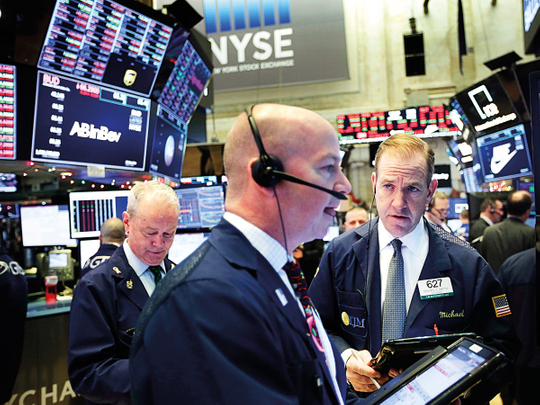
LONDON: World stocks on rebounded Friday as they zigzagged towards the year-end finishing line with dizzying volatility, dealers said.
Led by Wall Street’s roller coaster ride, equity trading during Christmas week has not been for the faint-hearted — or anyone hoping that markets could still somehow eke out gains for 2018.
“The final trading week of 2018 has been explosively volatile and wildly unpredictable,” said analyst Lukman Otunuga at FXTM.
“Global sentiment repeatedly swung from extremely bearish to bullish this week as investors tussled with concerns over slowing global growth, US-China trade developments, Brexit-related uncertainty and a partial US government shutdown.”
Frankfurt ended its final, shortened session of the year with a 1.7 per cent gain, which eased some of the pain from a whopping annual loss, but even so, the Dax index still lost 18.3 per cent for the year 2018.
‘Stonking’
Other European stocks were also higher by the mid-afternoon, building on the previous day’s late surge on Wall Street after a New York session that analysts at Accendo described as “another stonking stateside see-saw”.
Markets were behaving like they wanted to compress a year’s worth of excitement into the space of just a few days, they said, making for “a surprisingly volatile end to the trading year”.
At Friday’s opening on Wall Street, the Dow Jones index built on the previous session’s late gains as bargain hunters swooped in, dealers said. About 15 minutes into trading, the Dow Jones Industrial Average stood at 23,266.54, up 0.6 per cent.
The broad-based S&P 500 advanced 0.7 per cent to 2,506.88, while the tech-rich Nasdaq Composite Index climbed 0.8 per cent to 6,629.10.
Dealers said they were still reeling from Thursday’s session which, after staging its best rally in nine years the day after Christmas, had opened meekly — and losses accelerated following disappointing consumer confidence data.
However, a rally in the last 30 minutes caused the Dow to stage a comeback, ending up 1.1 per cent at the close as worries over the economy also gave way to bargain-hunting.
“This rollercoaster ride is unlikely to stop anytime soon as investors continue to wear emotions on their sleeve,” said Oanda analyst Stephen Innes.
Tokyo’s 2018 loss
Asian indices moved with caution on Friday after days of volatility on global markets failed to boost confidence.
But Tokyo’s benchmark Nikkei index ended the year with its first loss since 2011, trading in negative territory throughout Friday.
“It’s inevitable that selling emerges after sharp rises like yesterday’s,” said Makoto Sengoku, market analyst at Tokai Tokyo Research Centre.
Over the year, Tokyo’s bellwether index has lost more than 10 per cent.
“The Nikkei scored annual gains for the past six years under Abenomics but it’s not the case any more,” Sengoku said, referring to Prime Minister Shinzo Abe’s pro-spending policies.
“This is because of large swings caused by the Trump administration rather than domestic problems,” he told AFP, noting President Donald Trump’s trade spat with China also weighed.
Elsewhere on Friday, Hong Kong closed up 0.1 per cent, while Shanghai added 0.4 per cent in a modest end to its last trading day of 2018.
In commodities action, oil prices rebounded by more than a dollar at the end of a topsy-turvy week.
Star performer gold held close to its highest level for more than six months, as investors sought out the haven investment.
The glamorous precious metal had spiked on Thursday as high as $1,284.75 an ounce.
“It is shaping up to be an incredibly positive trading week for gold prices thanks to heightened geopolitical risks and dollar weakness,” added Otunuga.
“Explosively volatile equity markets, global growth fears, Brexit uncertainty and political instability in Washington have accelerated the flight to safety — ultimately sending gold prices to levels not seen in more than six months.”
In addition, the weak greenback makes dollar-priced commodities cheaper for buyers using stronger currencies. That tends to stimulate demand and prices.












